A memorable itinerary that takes in the vast interior of Siena Cathedral with Museum, the Crypt, the Baptistery and the St Bernardino's Oratory to discover the human soul and the truths of faith revealed through culture and art.
The magnificent complex of the Works of the Cathedral in Siena includes a series of monuments that are among the most significant in the panorama of European art.The Sienese cathedral is undoubtedly the fulcrum of any itinerary aiming to capture the meaning be... more
The magnificent complex of the Works of the Cathedral in Siena includes a series of monuments that are among the most significant in the panorama of European art.The Sienese cathedral is undoubtedly the fulcrum of any itinerary aiming to capture the meaning behind the extraordinary persona of Saint Catherine and the role she played in the history of the Church and of Europe. However the Crypt, the Baptistery and the Museum of the Works of the Cathedral are also a significant part of the same large complex that includes both the "Old Cathedral" and the "New Cathedral". In the cathedral there are numerous sculptures, masterpieces of art of all time, made by some of the greatest artists: Nicola Pisano sculpted the famous Pergamum, or Pulpit; Donatello sculpted a bronze effigy of St. John the Baptist which is kept in the chapel dedicated to Saint John the Baptist; Michelangelo sculpted four statues which are inserted in the niches of the Piccolomini Altar. During the Baroque era, the sculptural heritage of the Cathedral was enriched by two statues sculpted by Bernini for the Chapel of the Vow, one of the most representative places of worship. In the Piccolomini Library, on the left side of the Cathedral, you can admire the famous frescoes by Pinturicchio depicting the biography of the humanist Enea Silvio Piccolomini, Pope Pius II, as well as the grotesques of the vault, the marble statue group of the Three Graces (a Roman era copy from the Hellenistic original), and the precious 15th century codices put on display in glass cases. Besides the numerous sculptural and painted masterpieces, one of the most exceptional artistic expressions is the floor itself, a wonder in its own right, with its marble inlays and incisions that form together a program of both classical and religious inspiration. The work was created over the course of five centuries, between the fourteenth and the nineteenth century.
The visit continues to the Crypt, where we can admire a cycle of paintings that are at the origins of Italian painting itself, and to the Baptistery where we can find at least one extraordinary work of the early Renaissance, the famous Baptismal Font. The gilded bronze panels, with Stories of St. John the Baptist, were in fact conceived by artists such as Jacopo della Quercia, Lorenzo Ghiberti and Donatello. The evocative decoration of the vaults frescoed by Vecchietta illustrates the articles of the Creed, which constitute the Profession of Faith required of catechumens for admission to Baptism. In the Museum of the Works of the Cathedral, which has preserved the precious works of art from the Cathedral for over a hundred years, we can admire the 13th century works of Duccio di Buoninsegna: the large gothic stained glass window (the first of its kind in Italy), and the Maestà, a large fourteenth-century altarpiece, a masterpiece of medieval European art. We can also admire the statues of Giovanni Pisano which had decorated the facade of the Cathedral; Donatello's marble sculpture Our Lady of Forgiveness, and Bernini's Golden Rose, together with numerous pictorial masterpieces from the Sienese school and an important collection of jewelery and textiles. From the top of the Façade you can get a stunning view of the city and the surrounding Tuscan countryside. The sixteenth-century Oratory of San Bernardino, where the Diocesan Museum of Sacred Art is located, has a cycle of frescoes depicting the story of the Virgin Mary along with the famous Virgo Lactans painting by Ambrogio Lorenzetti.
lessCathedral, Piccolomini Library, Opera Museum,
Panorama from the Facade, Crypt, Baptistery:
from 1st April to 31st October
from 10:00 a.m. to 6:00 p.m.
from 1st November to 31st March
from 10:30 a.m. to 5:30 p.m.
on feast days the Cathedral opens at 1.30 p.m.
Voucher Exchange Ticket Office:
Piazza Duomo, 7 - 53100 Siena
Cathedral, Opera Museum
and Piccolomini Library
Piazza del Duomo
Crypt:
Scalinata di San Giovanni
Baptistery:
Piazza San Giovanni
St Bernardino's Oratory:
Piazza San Francesco
By car:
From the north: A1 'Firenze Impruneta' exit, then Florence/Siena dual carriageway (40min.).
From the south: A1 "Valdichiana" exit, then Bettolle-Siena link road (2h 30min.)
The Duomo is located within the city's historic centre, so it is not possible to reach it directly by car. Arriving by car, it is advisable to exit at Siena Ovest and reach the Duomo car park, or exit at Siena Sud and reach the Il Campo car park. For info: www.sienaparcheggi.it
By train:
Visit www.trenitalia.com for the timetables of connections from Rome, Florence, Pisa and Grosseto. Siena Railway Station is in Piazza Carlo Rosselli, about 2 km from the city centre. From the railway station to the centre, the journey time by bus is approximately 5 minutes (for info: city bus timetable).
By bus:
Connections from major cities such as Rome and Florence.
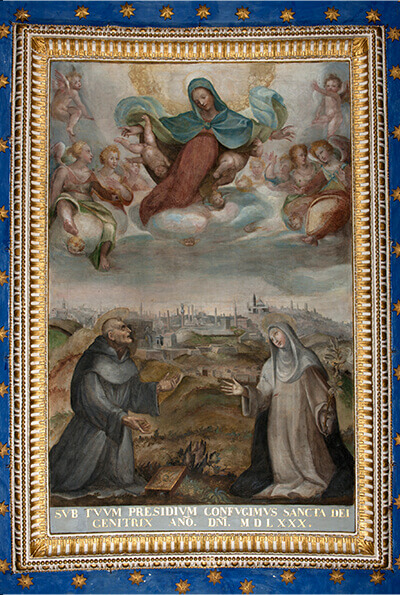
The architectural structure of the Oratory of San Bernardino dates back to the late medieval period. It was completely renovated during the sixteenth century. It is a very suggestive place, one of the most interesting museum spaces in Siena, as it is able to offer an overall overview of the Sienese pictorial production from the thirteenth century onward. The Diocesan Museum of Sacred Art is situated in some adjacent spaces.
The building, originally intended to house the Confraternity of the Virgin Mary and of Saint Francis, was dedicated in the sixteenth century to Saint Bernardino. Friar Bernardino Albizzeschi often held fervent sermons in the town square in front. He was canonized in 1450. The entrance of the Oratory consists of an elegant travertine portal. Beyond the entrance, the environment is filled with lunettes which were frescoed between the end of the sixteenth and seventeenth centuries and which depict episodes related to the miracles in the life of Saint Bernardino. The splendid chapel of the upper oratory dedicated to Saint Mary of the Angels constitutes the heart of the museum: it was completely frescoed in the early sixteenth century by Domenico Beccafumi, Giovanni Antonio Bazzi known as Sodoma, and Girolamo Pacchia. The iconographic program present in the scenes that unfold along the walls of the oratory, with Stories from the life of Our Lady, aims to celebrate the Assumption of the Virgin Mary in body and soul.
less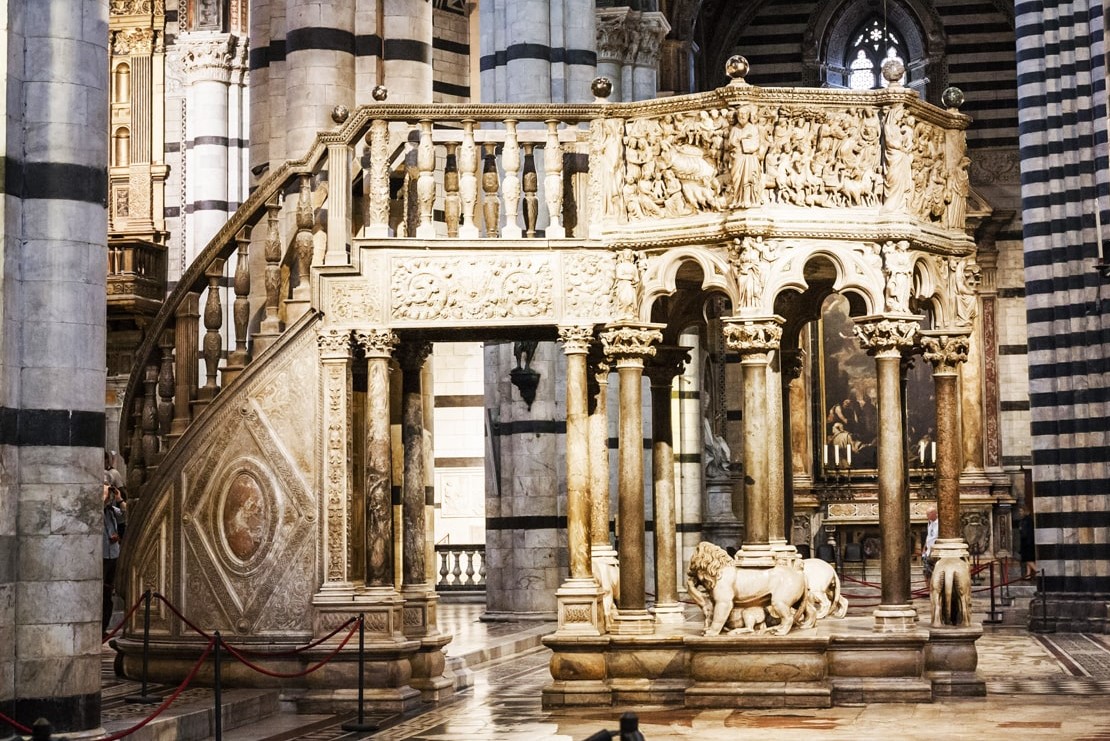
The octagonal pulpit, sculpted by Nicola Pisano between the years 1265 and 1268, was used to announce the Resurrection of Jesus and to proclaim his Gospel during the eucharistic celebrations.
The aim of his scheme of iconography was to illustrate Christian doctrine as regards redemption, and is outlined in three levels: on the lower level, next to lions and lionesses, the Liberal Arts and Philosophy through which man rises to God are depicted. Following, we have the Virtues, the Evangelists and the Prophets, inserted in the corners and plumes of the octagon. The coming of Christ who saved humanity is illustrated in the tiles of the gallery. The following scenes are depicted, one after the other: the Visitation and the Nativity; the Journey and the adoration of the Magi; the Presentation in the Temple and the Flight into Egypt; the Massacre of the Innocents; the Crucifixion; the Final judgement. The iconography of the reliefs follow a scheme based on the structure of the Gospels: we have in front of us, in fact, a Gospel carved into stone.
less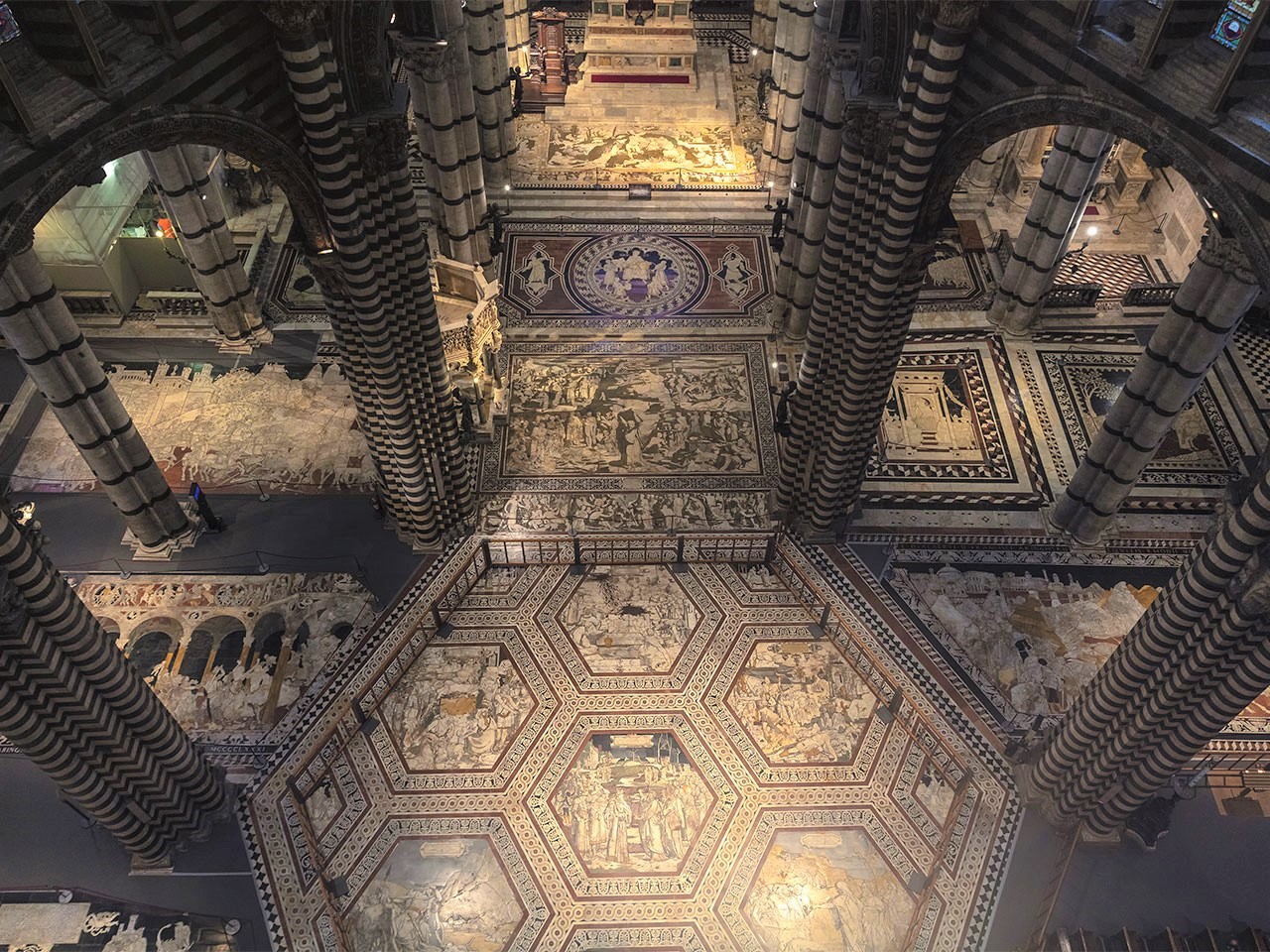
Though the Cathedral of Siena preserves a number of artistic masterpieces, perhaps the most exceptional masterpiece of all is the artistic floor, which took 5 centuries to complete, having been created between the fourteenth and the nineteenth century: the artistic floor was created utilizing the opus sectile technique, as the result of a program of classical and religious inspiration.
The conceptual program of the various artists was imprinted in the floor by means of the opus sectile technique. In the three naves the themes relate to classical and pagan antiquity: The she-wolf nursing the twins; Hermes trismegistus, the founder of human wisdom; the ten Sibyls who gave their oracular responses in various parts of the world; the philosophers who rejected wealth in order to better understand the depth of the human soul in its relationship with divinity. In the transept and in the choir the themes touch on the history of the Jewish people together with the events of salvation history which finds its fullfillment in Christ, who is constantly evoked but never explicitly represented in the artistics panels of the floor, seeing He is present on the altar itself during the Eucharistic celebration. It is there that the whole artistic program of the floor converges.
less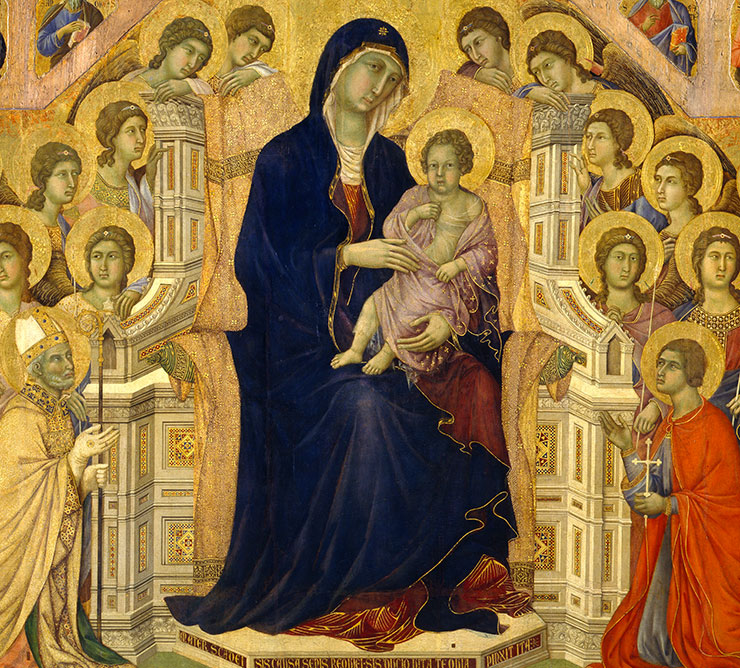
The magnificent altarpiece with Duccio di Buoninsegna's Maestà can be found on the first floor of the Museum, in a nice air-conditioned room. It is an absolute masterpiece of early fourteenth-century Italian painting, and the true charm of the entire collection.
Duccio received the commission for the panel in 1308, and completed it in June 1311. A solemn procession accompanied the piece to its proper place on the main altar of the cathedral. On the front, Our Lady is seated on a throne, and surrounded by a court of angels and saints. She is the perfect image of the mysterious reality of the Church. In fact, like the Church, Mary, though fully human, carries the divine mystery of the Son of God in her womb, to whom she birth and who she offers to those men who seek the path of their destiny. On the back, the Passion of the Christ is told in twenty-six squares. A predella and a crown completed the work and were painted on both sides. The predella, placed below the central panel, contained the Stories of Jesus' infancy on the back, and Episodes from his public ministry on the front. The crown depicted Stories from the Life of Our Lady on the back, and Stories of Our Lord after the resurrection on the front.
less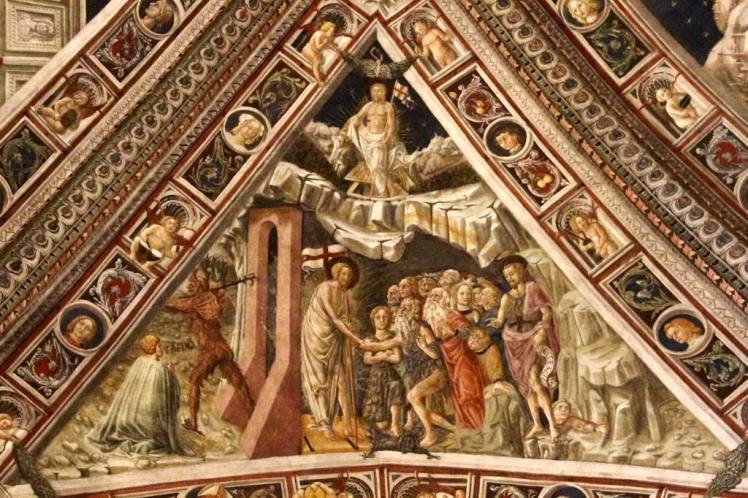
In 1450, Lorenzo di Pietro, known as "il Vecchietta", was commissioned to decorate the vaults of the Sienese Baptistery, continuing the work already set up by the Bolognese painter Agostino di Marsiglio. The church has a rectangular layout, divided into three naves by two substantial pillars; each nave includes two bays with rib vaults. The figures of the Apostles appear in those near the entrance, while the Articles of the Credo are represented in the sections of the ribbed vaults adjacent the back wall.
There are twelve scenes, four for each bay, which are in succession in an anticlockwise fashion. Abstraction and metaphysical rigor characterize the various scenes, including: the Ascension (sixth section), where Christ, placed frontally in the fiery almond, is seated for eternity in the high heaven; the descent of the Holy Spirit (eighth section) where the dove is submerged by a beam of light that radiates on the host raised in the chalice; the allegory of the Catholic Church (ninth section) in which the pontiff rests on St. Peter half-lying on the ground. With his left hand, the pope hands over the keys to the founder of the Catholic Church while with the other hand he administers baptism, an instrument of salvation, to a catechumen immersed in the water of a gilded bronze fountain, in the presence of a believer kneeling with hands joined in prayer, in the act of uttering the word "I BELIEVE", as happens in each of the other sections.
less